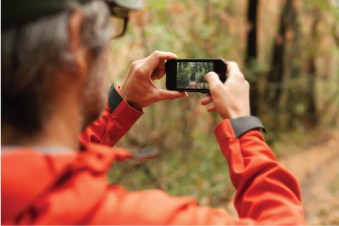In his 20-minute Speed Session at NRPA Congress last year, professional photographer John R. Johnson packed the room to share his secrets on making the best use of a cell phone for photography – a beneficial skill for park and recreation professionals working to raise awareness of programs, services and special places in the community through visual communications. Here, he shares a few tricks and previews his 2014 Speed Session reprise.
 A twist on an old saying goes something like this . . . “Friends don’t let Friends take professional photographs with a cell phone.”
A twist on an old saying goes something like this . . . “Friends don’t let Friends take professional photographs with a cell phone.”
Yet here I am, a card-carrying and award winning professional photographer about to spill my guts on just how clever, convenient and sometimes professional a good cell phone camera can be. I must be kidding right? Well actually no. I am afraid I have slipped to the dark side and have used my cell phone to take ‘real’ photos and have occasionally used them for professional applications.
There it is . . . It is out there, I confess. Please don’t judge me.
My grandfather always used to lecture me about the rewards of using, “The proper tool for the proper job.” He was a tool guy and I loved to sneak into his forbidden tool shed to create my own little projects when he was gone. The shed was a sanctuary with all of his tools hung so perfectly on the pegboard. I remember, each tool with a painted outline showing its shape and whether it was missing or hanging ready for use.
For me to use a cell phone for serious photography is not only fundamentally wrong but it is also like me sneaking into the tool shed, I really shouldn’t be doing this, but look how cool the forbidden project turned out. I never have been good at being told no, or what I can or can’t do.
Classic photography on any level comes down to three elements . . .
- Light – Think about it, no light, no photo, Duh – but if you use dramatic light vs. crummy light, wow what a difference that can make on the impact of a photograph.
- Exposure – Good ole F-Stops and Shutter Speeds – If you blow that, you blow the photograph. With today’s modern cameras and auto exposure, you will have a hard time missing the exposure, but you still can control motion and depth of field, a hallmark of good photography.
- Composition – Now here is where the true artist deep down inside of you can come out and shine. This is truly the difference between a great photo and a not-so-great photo. Top photographers do this instinctively – bad photographers get lucky once in a while and dance a little jig to celebrate.
I have found that with cell phone photography all the same rules apply as with the most state-of-the-art professional camera. Some shots suck, some do not and virtually 99% of the time it is because of these three elements which enhance or detract.
OK, so my job is to give clues to the clueless . . . which is precisely how anyone learned anything in life. We were not born into this we either learned it from someone (shortcuts) or used trial and error (the hard way) to become good at something.
Here are a few of my favorite clues . . .
If light is so important than seek it out
That means shoot early and shoot late when the light is on the horizon and is far more intense, colored, and directional. It casts great shadows to create contrast. Get in the way of a good photograph and perhaps one will find you.
Dramatic light means tricky exposure
Be sure to shoot extra to not miss the moment, backlight, night photography, keeping the camera still all require some extra effort, so engage your brain, shoot extra exposures and carefully check your results while still on location, not later when the special light has passed.
Change your view for Composition
One of the greatest tips on Composition I ever learned is to change the way we see everything in life. Get higher – get lower – move closer – change your angle - add elements in a frame and use a telephoto (yes you can do that with a cell phone camera, but you will have to come to my Speed Session at NRPA Congress to learn that trick) Please imply movement – and for the love of art . . . stop putting everything in the middle of the frame, give your subject space in the frame to move to.
Seriously a 750 word blog entry is not going to make you a photography superstar overnight, nor will a 20 minute Speed Session at NRPA Congress, but what it will do is open your eyes to a few thoughts, tricks and classic photography procedures which will absolutely make your next photograph a masterpiece, even if only your Mother thinks so at this moment, she can become your first fan.
Learn more about the NRPA Annual Conference.
 John R. Johnson a professional golf and resort photographer, led a wildly popular 20 minute Speed Session on Cell Phone Photography at the 2013 NRPA Congress. He and his Speed Session were back by popular demand at the 2014 NRPA Congress in Charlotte.
John R. Johnson a professional golf and resort photographer, led a wildly popular 20 minute Speed Session on Cell Phone Photography at the 2013 NRPA Congress. He and his Speed Session were back by popular demand at the 2014 NRPA Congress in Charlotte.

